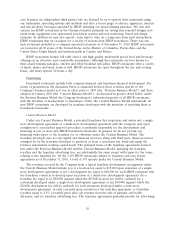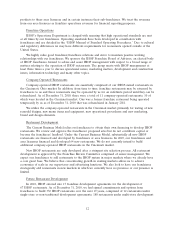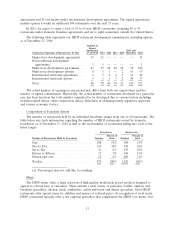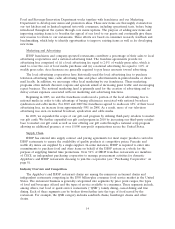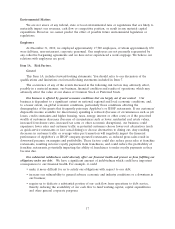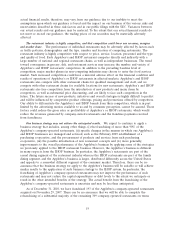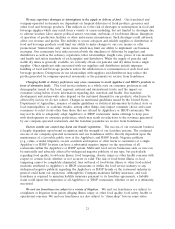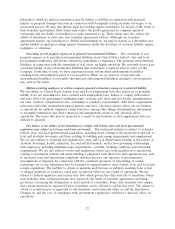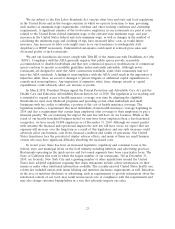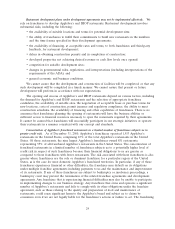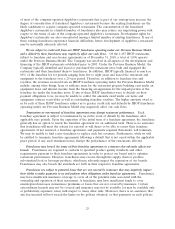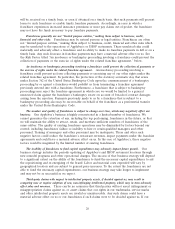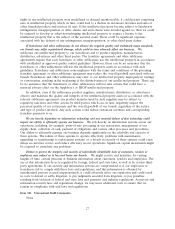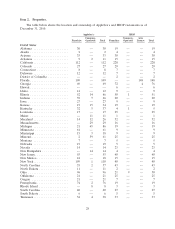IHOP 2010 Annual Report Download - page 35
Download and view the complete annual report
Please find page 35 of the 2010 IHOP annual report below. You can navigate through the pages in the report by either clicking on the pages listed below, or by using the keyword search tool below to find specific information within the annual report.actual financial results, therefore, may vary from our guidance due to our inability to meet the
assumptions upon which our guidance is based and the impact on our business of the various risks and
uncertainties described in these risk factors and in our public filings with the SEC. Variances between
our actual results and our guidance may be material. To the extent that our actual financial results do
not meet or exceed our guidance, the trading prices of our securities may be materially adversely
affected.
The restaurant industry is highly competitive, and that competition could lower our revenues, margins
and market share. The performance of individual restaurants may be adversely affected by factors such
as traffic patterns, demographics and the type, number and location of competing restaurants. The
restaurant industry is highly competitive with respect to price, service, location, personnel and the type
and quality of food. Each Applebee’s and IHOP restaurant competes directly and indirectly with a
large number of national and regional restaurant chains, as well as independent businesses. The trend
toward convergence in grocery, deli, and restaurant services may increase the number and variety of
Applebee’s and IHOP restaurants’ competitors. In addition to the prevailing baseline level of
competition, major market players in non-competing industries may choose to enter the food services
market. Such increased competition could have a material adverse effect on the financial condition and
results of operations of Applebee’s or IHOP restaurants in affected markets. Applebee’s and IHOP
restaurants also compete with other restaurant chains for qualified management and staff, and we
compete with other restaurant chains for available locations for new restaurants. Applebee’s and IHOP
restaurants also face competition from the introduction of new products and menu items by
competitors, as well as substantial price discounting, and are likely to face such competition in the
future. The future success of new products, initiatives and overall strategies is highly difficult to predict
and will be influenced by competitive product offerings, pricing and promotions offered by competitors.
Our ability to differentiate the Applebee’s and IHOP brands from their competitors, which is in part
limited by the advertising monies available to us and by consumer perception, cannot be assured. These
factors could reduce the gross sales or profitability at Applebee’s or IHOP restaurants, which would
reduce the revenues generated by company-owned restaurants and the franchise payments received
from franchisees.
Our business strategy may not achieve the anticipated results. We expect to continue to apply a
business strategy that includes, among other things, (i) the franchising of more than 90% of the
Applebee’s company-operated restaurants, (ii) specific changes in the manner in which our Applebee’s
and IHOP businesses are managed and serviced, such as the February 2009 establishment of a
purchasing cooperative, and the procurement of products and services from such purchasing
cooperative, (iii) the possible introduction of new restaurant concepts and (iv) more generally,
improvements to the overall performance of the Applebee’s business by applying some of the strategies
we previously applied to the IHOP restaurant business. However, the Applebee’s business is different
in many respects from the IHOP business. In particular, the Applebee’s restaurants are part of the
casual dining segment of the restaurant industry whereas the IHOP restaurants are part of the family
dining segment, and the Applebee’s business is larger, distributed differently across the United States
and appeals to a somewhat different segment of the consumer market. Therefore, there can be no
assurance that the business strategy we apply to the Applebee’s business will be suitable or will achieve
similar results to the application of such business strategy to the IHOP system. In particular, the
franchising of Applebee’s company-operated restaurants may not improve the performance of such
restaurants and may not reduce the capital expenditures or debt levels to the extent we anticipate or
result in the other intended benefits of the strategy. The actual benefit from the franchising of the
Applebee’s company-operated restaurants is uncertain and may be less than anticipated.
As of December 31, 2010, we have franchised 193 of the Applebee’s company-operated restaurants
acquired on November 29, 2007. There can be no assurance that we will be able to complete the
refranchising of a substantial majority of the remaining 309 company-operated restaurants on terms
19



